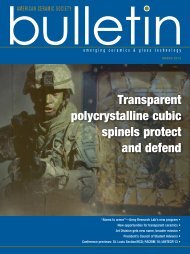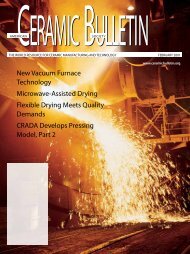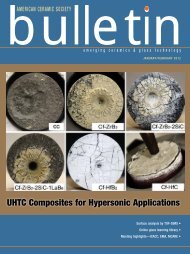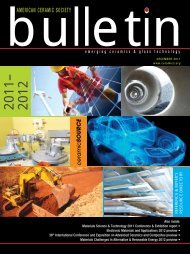American Ceramic Society Bulletin
American Ceramic Society Bulletin
American Ceramic Society Bulletin
Create successful ePaper yourself
Turn your PDF publications into a flip-book with our unique Google optimized e-Paper software.
ceramics in the environment<br />
Cabot launches new aerogel<br />
additives for coatings<br />
The holy grail for thermal insulation<br />
is a practical (i.e, inexpensive<br />
and easy to use) product that incorporates<br />
silica-based aerogel, and, at<br />
first glance, Cabot’s new Enova line of<br />
aerogel particles appears to be a step in<br />
the right direction.<br />
Bulk silica aerogel is a hydrophobic<br />
superinsulator, but it is extremely brittle<br />
and, therefore, not so easy to manufacture<br />
in quantity, transport, use in large<br />
sizes, etc. Some niche applications have<br />
been found where the size of the products<br />
are small and buyers are willing to<br />
pay a premium for the extra performance.<br />
Other companies, such as Cabot,<br />
ThermoBlok and Aspen, also have<br />
been trying to find a useful middle<br />
ground, where some thickness and<br />
performance characteristics are being<br />
traded off for ease-of-use considerations.<br />
And, so far, even these are being aimed<br />
at high-payoff types of applications,<br />
such as pipelines and storage tanks,<br />
where added temperature control can<br />
yield major energy savings and to create<br />
thermal barriers in isolated construction<br />
elements, such as steel stud facings.<br />
Cabot’s innovation in aerogel seems<br />
to be developing a product aimed specifically<br />
at the coatings market. Although<br />
the reliance on particles rather than<br />
sheets of aerogel decreases the potential<br />
for insulation, this disadvantage could<br />
be offset by the advantage of being easily<br />
sprayed on using standard manufacturing<br />
and constructon equipment.<br />
An announcement from the company,<br />
timed to coincide with the opening of<br />
the European Coatings Show, says that,<br />
“applying a [1-millimeter] coating containing<br />
Enova aerogel to a 200°C metal<br />
surface meets U.S. and European testing<br />
protocols for safe touch temperature, preventing<br />
the first-degree burns one would<br />
normally expect within five seconds of<br />
skin contact. A thicker application, such<br />
as a [2-millimeter] coating results in a<br />
reduction in energy use of 30 percent for<br />
uninsulated metal vessels maintained at<br />
70°C. This can easily translate to poten-<br />
Cabot’s Enova 3110 aerogel particles.<br />
tial applications as wide ranging as home<br />
and commercial appliances, process piping,<br />
building and tank storage.”<br />
Cabot says the thermal conductivity<br />
of the particles is 12 milliwatts per<br />
meterper degree kelvin. Although this<br />
is theoretically better than polyurethane<br />
foam (30 mW/m·K), the company<br />
admits that the thermal conductivity<br />
of Enova can exceed polyurathane (30<br />
mW/m·K to 50 mW/m·K) when the particles<br />
are used as an additive in a waterborne<br />
formulation. Cabot points out<br />
that this is still seven to 10 times more<br />
insulative than standard paint – and I<br />
suspect that the company will be looking<br />
to develop some partnerships with<br />
paint manufacturers and construction<br />
material suppliers.<br />
The Enova brand actually encompasses<br />
three types of aerogel products,<br />
which are mainly differentiated by<br />
particle size: 0.1–0.7 millimeter, 0.1–1.2<br />
millimeter and 2–40 micrometer.<br />
James Pidhurney, Cabot’s manager<br />
for the Enova products, predicts in<br />
the company’s announcement that<br />
big changes may be in store. He says<br />
the, “Enova aerogel [additive] creates<br />
a paradigm shift in how the industry<br />
thinks about insulation and coatings,<br />
two products which were once mutually<br />
exclusive. In the past, if you wanted<br />
flexibility in a coating, you had to<br />
compromise on insulation performance.<br />
Enova additives enable a new class of<br />
coatings that deliver[s] the performance<br />
of traditional insulation and the flexibility<br />
of a coating in a single product.”<br />
Visit: www.cabot-corp.com/aerogel/<br />
coatings n<br />
Leaking water infrastructure is<br />
$20B annual market, according<br />
to Lux, and growing<br />
Lux Research has just published a<br />
new research report, “Patching Water<br />
Infrastructure Where it Leaks Money.”<br />
Lux divides the opportunities into<br />
two categories: pipe repair solutions and<br />
monitoring solutions.<br />
Pipe repair, at first glance, seems<br />
straight forward, but Lux senior<br />
researcher Brent Giles is unexcited<br />
about this sector, saying there is little<br />
technical innovation. He argues that the<br />
big money in this market is in monitoring<br />
solutions for water and waste systems.<br />
The analogy he draws is to Smart<br />
Grid technology that is enabling utilities<br />
to monitor their systems in real time,<br />
and to target resources and repairs.<br />
According to Giles, water/waste<br />
managers likewise need to benefit from<br />
advances in information technologies.<br />
They need real-time and detailed<br />
monitoring of the water infrastructure,<br />
which also can alert them to a range of<br />
problems, including storm surges and<br />
contaminant dumping.<br />
Giles, who authored the report, says<br />
software and sensor technologies can<br />
provide a dynamic picture of a water<br />
utility’s entire infrastructure. “Without<br />
this holistic view, utilities cannot prioritize<br />
the most critical repairs – and may<br />
end up throwing money down the drain<br />
to address the leaks that are visible<br />
today rather than the ones that could<br />
prove catastrophic tomorrow,” he says.<br />
Giles says, however, to think beyond<br />
“Smart Water Meters.” There are new<br />
opportunities in leak and chemical<br />
detectors, underground mapping systems<br />
(such as LIDAR), algorithmic event<br />
predictors and systems for processing and<br />
responding to Smart Meter data.<br />
He says some managers need to own<br />
three-dimensional maps that show<br />
exactly where the pipe is. The next<br />
step will be to start placing detectors<br />
and dynamic meters and simultaneously<br />
begin to create event models.<br />
Visit www.luxresearchinc.com n<br />
14 <strong>American</strong> <strong>Ceramic</strong> <strong>Society</strong> <strong>Bulletin</strong>, Vol. 90, No. 4<br />
(Credit: Cabot.)






